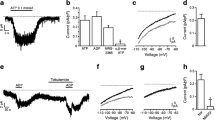Abstract
It has been proposed that mastoparan (INLKALAALAKKIL) and other mast cell secretagogues such as substance P (SP) or compound 48/80 act by direct activation of the pertussis toxin (PTX)-sensitive G-proteins in intact cells. Here we have investigated whether or not the antagonists of SP, [D-Trp7, 9, 10] SP1-11 and [D-Trp7, 9, 10, N-leu11] SP1-11, can similarly induce exocytosis from RINm5F cells. In intact cells mastoparan and the SP antagonists stimulated insulin release in a dose-dependent manner at concentrations ranging from 10 to 100 µM. The maximal effect on insulin release, of both mastoparan and the SP antagonists was comparable to that obtained with 100 µM forskolin. Pretreatment of the intact cells, for 18 h with PTX or 6 h with cholera toxin, did not change the responses induced by both mastoparan and the SP antagonists. This absence of PTX effect, despite the fact that the three PTX substrates at 41, 40 and 39 kDa were ADP ribosylated after pretreatment suggests intrinsic differences between mast and RINm5F cells. Thus the SP antagonists behave similarly to mastoparan in its ability to induce insulin release in RINm5F cells. However, the higher concentrations required with RINm5F cells compared to that needed for mast cells suggest differences either in G-proteins composition or in the phospholipid composition of the membranes.
Similar content being viewed by others
Abbreviations
- SP-Substance P:
-
SPa:[d-Trp7, 9, 10] SP1−11, SPb:[D-Trp7, 9, 10, N-leu11]SP1−11
References
Hirai Y, Yasuhara T, Yoshida H, Nakajima T: A new mast cell degranulating peptide ‘mastoparan’ in the venom of Vespula lewisii. In: S Shiba (ed.) Peptide Chemistry. Osaka, Protein Research Foundation, 1978, pp 155–160
Higashijima T, Wakamatsu K, Takemirsu M, Fujino M, Nakajima T, Miyazawa T: Conformational change of mastoparan from wasp venom on binding with phospholipid membrane. FEBS Lett 152: 228–230, 1983
Wakamatsu K, Higashijima T, Fujino M, Nakajima T, Miyazawa T: Transferred NOE analyses of conformations of peptides as bound to membrane bilayer of phospholipid; mastoparan-X. FEBS Lett 162: 123–125, 1983
Higashijima T, Uzu S, Nakajima T, Ross EM: Mastoparan, a peptide toxin from Wasp Venom, mimics receptors by activating GTP-binding Regulatory Proteins (G Proteins). J Biol Chem 263: 6491–6494, 1988
Strader CD, Sigal IS, Dixon RAF: Structural basis of β-adre-nergic receptor function. FASEB J 3: 1825–1832, 1989
Cheung AH, Sigal IS, Dixon RAF, Strader CD: Agonist-promoted sequestration of the β2-adrenergic receptor requires regions involved in functional coupling with Gs. Mol Pharmacol 34: 132–138, 1989
Mousli M, Bronner C, Bueb JL, Tschirhart E, Gies JP, Landry Y: Activation of rat peritoneal Mast Cells by Substance P and Mastoparan. J Pharmacol Exp Ther 250: 329–335, 1989
Argiolas A, Pisano JJ: Facilitation of phospholipase A, activity by mastoparans, a new class of mast cell degranulating peptides from wasp venom. J Biol Chem 258: 13697–13702, 1983
Hirai Y, Kuwada T, Yoshida H, Nakajima T: A new mast cell degranulating peptide homologous to mastoparan in the venom of Japanese hornet (Vespa xanthoptera). Chem Pharm Bull 27: 1945–1946, 1979
Kuroda Y, Yoshioka M, Kumakura K, Kobayashi K, Nakajima T: Effects of peptides on the release of catecholamines and adenine nucleotides from cultured adrenal chromaffin cells. Proc Japan Acad 56: 660–664, 1980
Kurihara H, Kitajima K, Senda T, Fujita H, Nakajima T: Multigranular exocytosis induced phospholipase A,-activators, melittin and mastoparan, in rat antrerior pituitary cells. Cell Tissue Res 243: 311–316, 1986
Burgoyne RD: Control of exocytosis. Nature 328: 112–113, 1987
Korman LY, Bhathena SJ, Voyles NR, Oie HK, Recant L: Characteristics of the interaction of the glucagon receptor, cAMP and insulin secretion in parent cells and clone 5F of a cultured rat insulinoma. Diabetes 34: 717–722, 1985
Amiranoff B, Lorinet AM, Lagny-Pourmir I, Laburthe M: Mechanism of galanin-inhibited insulin release. Eur J Biochem 177: 147–152, 1988
Lambert DG, Atkins TW: Nutrient induced insulin release from an insulinoma derived β-cell line. Acta Diabetol Lat 24: 299–304, 1987
Herbert V, Law KS, Gottlieb CW, Bleicher SJ: Coated charcoal immunoassay of insulin. J Clin Endocr 25: 1375–1384, 1965
Toutant M, Aunis D, Bockaert J, Homburger V, Rouot B: Presence of three pertussis toxin substrates and Go immunoreactivity in bot plasma and granule membranes of chromaffin cells. FEBS Lett 215: 339–344, 1987
Zar, JH: Biostatistical analysis. Englewood cliffs. N.J. Prentice Hall, 1974, pp 151–181
Henquin JC, Lambert A: Cobalt inhibition of insulin secretion and calcium uptake by isolated rat islets. Am J Physiol 228: 1669–1677, 1975
Henquin JC, Meissner HP: The ionic, electrical, and secretory effects of endogenous cyclic adenosine monophosphate in mouse pancreatic β-cells: studies with forskolin. Endocrinology 115: 1125–1134, 1984
Nakako Y, Mitsuhisa K, Teiji T, Toru A, Takashi Y: Mastoparan, a wasp venom, stimulates insulin release by pancreatic islets through pertussis toxin sensitive GTP-binding protein. Biochem Biophys Res Commun 158: 712–716, 1989
Vallar L, Biden J, Wollheim CB: Guanine necleotide induce Ca2−-independent insulin secretion from permeabilized Rin m 5F cells. J Biol Chem 262: 5049–5056, 1987
Wollheim CB, Ullrich S, Meda P, Vallar L: Regulation of exocytosis in electrically permeabilized insulin-secreting cells. Evidence for Ca2+ dependent and independent secretion. Bioscience Reports 7: 443–453, 1987
Chiba Y, Kawai K, Okuda Y, Munekata E, Yamashita K: Effects of substance P and substance P-(6–11) on hormone release from isolated perfused pancreas: their opposite actions on rat and canine islets. Endocrinology 117: 1996–2000, 1985
Mousli M, Bueb JL, Bronner C, Rouot B, Landry Y: G protein activation: a receptor-independent mode of action for cationic amphiphilic neuropeptides and venom peptides. Trends Pharmacol Sci 11: 358–362, 1990
Perianin A, Snyderman R: Mastoparan, a wasp venom peptide, identifies two discrete mechanisms for elevating cytosolic calcium and inositol triphosphates in human polymorphonuclear leukocytes. J Immunol 143: 1669–1673, 1989
Author information
Authors and Affiliations
Rights and permissions
About this article
Cite this article
Hillaire-Buys, D., Mousli, M., Landry, Y. et al. Insulin releasing effects of mastoparan and amphiphilic substance P receptor antagonists on RINm5F insulinoma cells. Mol Cell Biochem 109, 133–138 (1992). https://doi.org/10.1007/BF00229767
Issue Date:
DOI: https://doi.org/10.1007/BF00229767




